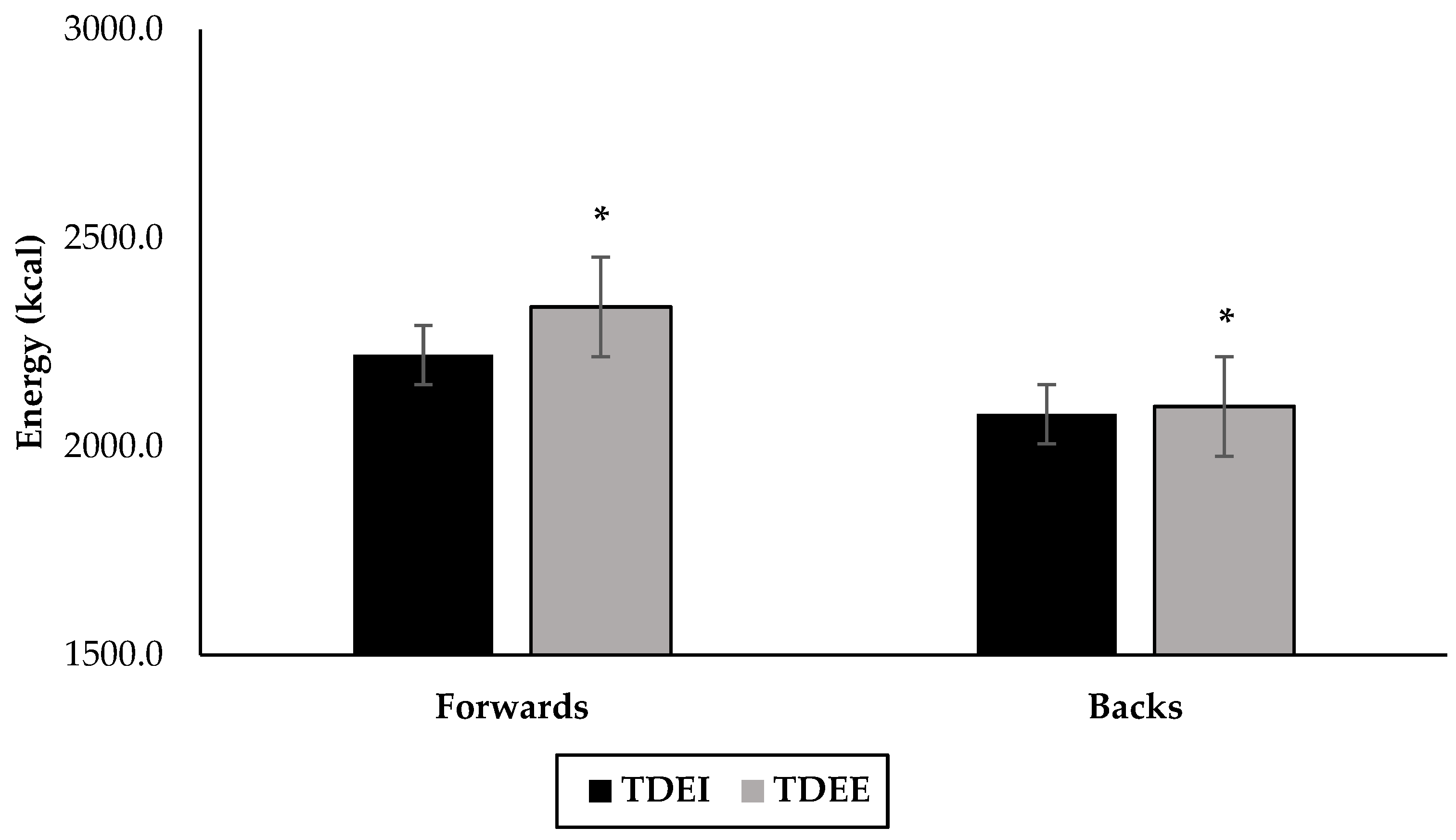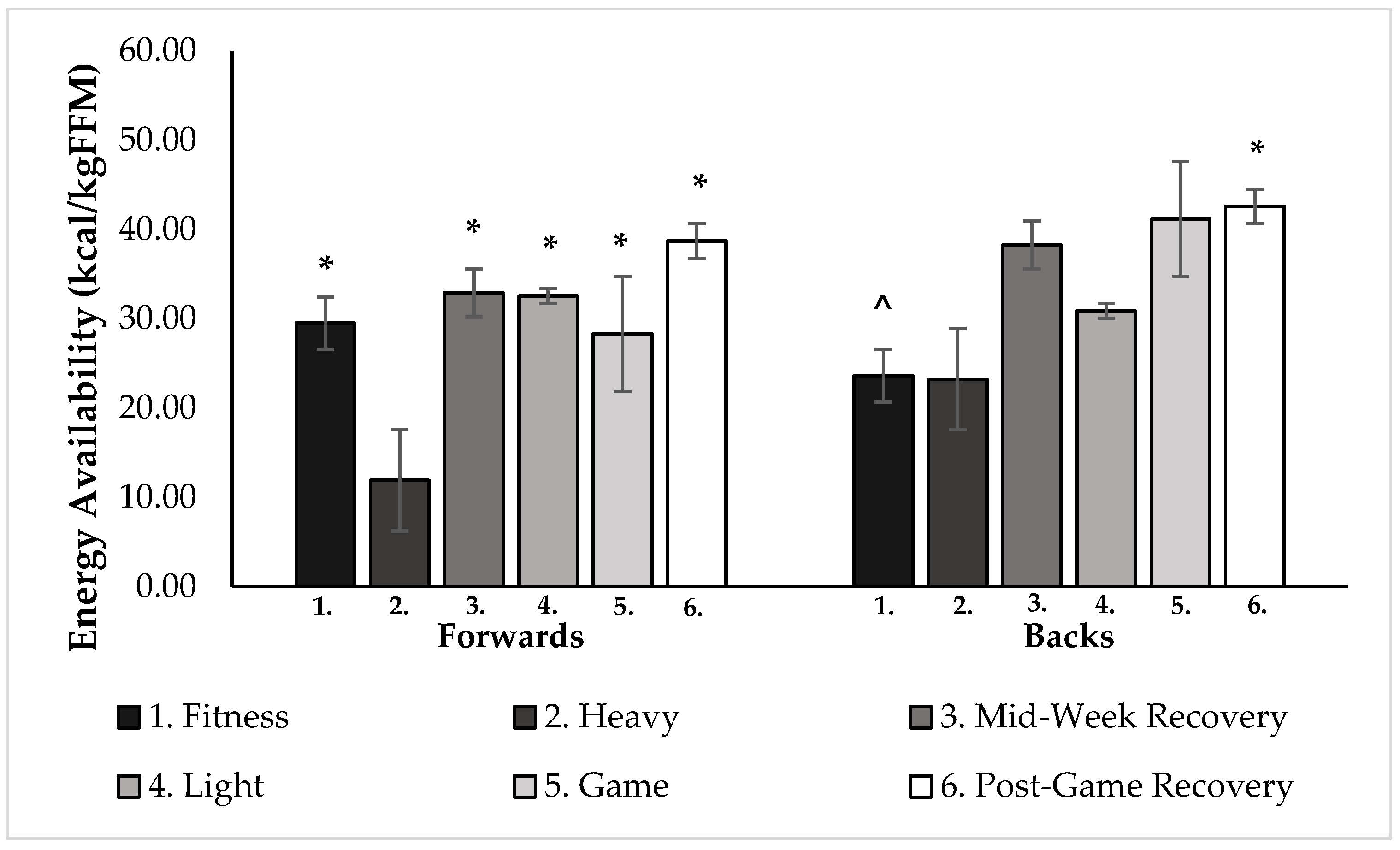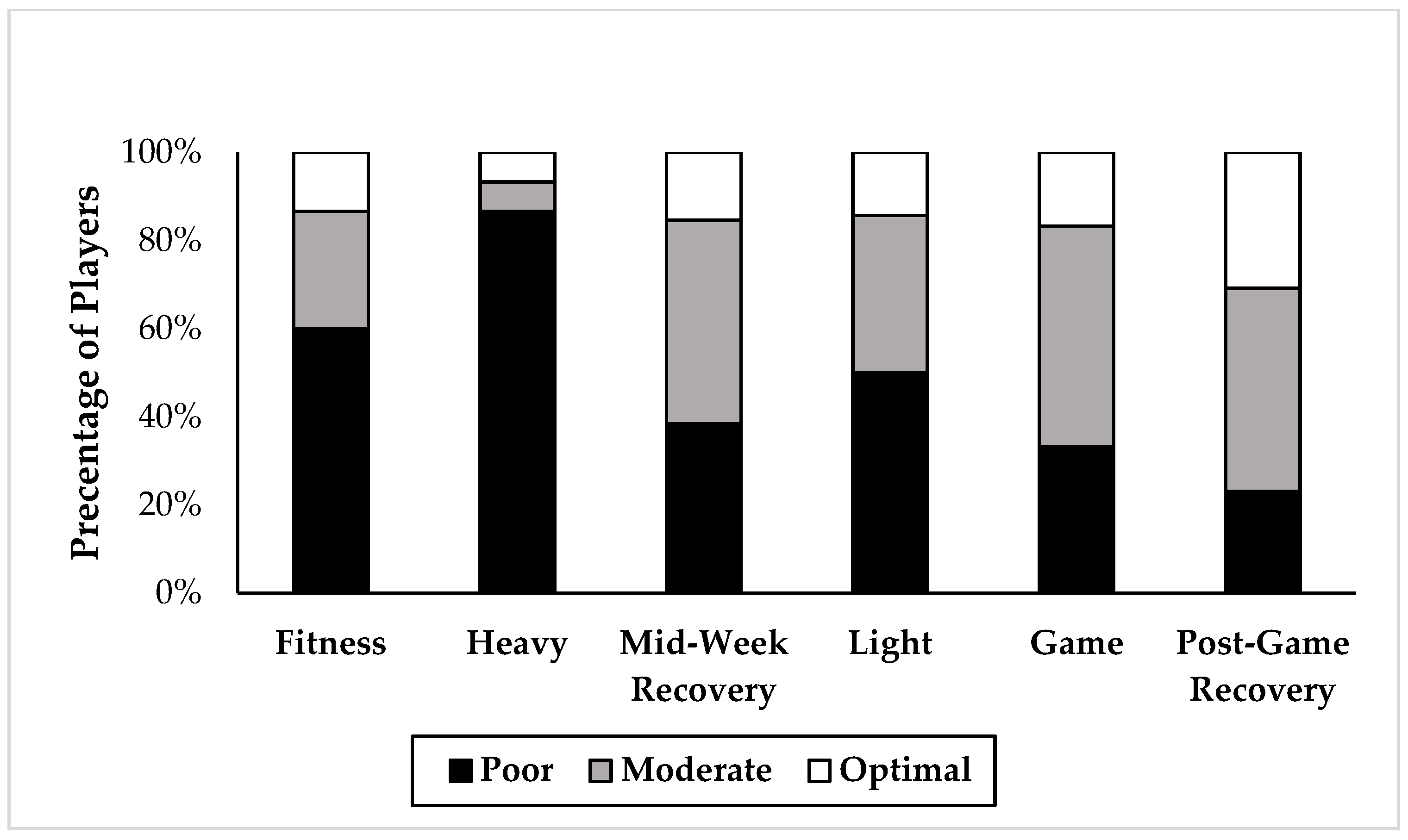Dietary Intake over a 7-Day Training and Game Period in Female Varsity Rugby Union Players
Abstract
:1. Introduction
2. Materials and Methods
2.1. Participants
2.2. Experimental Design
2.3. Anthropometry Measurements
2.4. Weekly Training Schedule
- Monday: “Fitness”
- Tuesday and Thursday: “Heavy”
- Wednesday: “Mid-Week Recovery”
- Friday: “Light”
- Saturday: “Game”
- Sunday: “Post-Game Recovery”
2.5. Energy Expenditure Estimates
2.6. Energy Availability
2.7. ESHA and Microsoft Excel Analysis
2.8. Statistics
3. Results
3.1. Total Energy Expenditure and Total Dietary Intake Results
3.2. Energy Availability
3.3. Average Macronutrient Intake/Distribution Results
4. Discussion
4.1. Energy Intake vs. Energy Expenditure Estimates
4.2. Energy Availability
4.3. Macronutrient Intake
4.3.1. Carbohydrates
4.3.2. Protein and Fat
5. Conclusions
Author Contributions
Funding
Institutional Review Board Statement
Informed Consent Statement
Acknowledgments
Conflicts of Interest
References
- Nicholas, C.W. Anthropometric and physiological characteristics of rugby union football players. Sports Med. 1997, 23, 375–396. [Google Scholar] [CrossRef] [PubMed]
- Duthie, G.; Pyne, D.; Hooper, S. Applied physiology and game analysis of rugby union. Sports Med. 2003, 33, 973–991. [Google Scholar] [CrossRef] [PubMed]
- Gabbett, T.; King, T.; Jenkins, D. Applied physiology of rugby league. Sports Med. 2008, 38, 119–138. [Google Scholar] [CrossRef] [PubMed]
- Zuniga, K.E.; Downey, D.L.; McCluskey, R.; Rivers, C. Need for and interest in a sports nutrition mobile device application among Division I collegiate athletes. Int. J. Sport Nutr. Exerc. Metab. 2017, 26, 43–49. [Google Scholar] [CrossRef] [PubMed]
- Manore, M.M. Weight management for athletes and active individuals: A brief review. Sports Med. 2015, 45, 83–92. [Google Scholar] [CrossRef] [Green Version]
- Kerr, G.; Berman, E.; De Souza, M.J. Disordered eating in women’s gymnastics: Perspectives of athletes, coaches, parents, and judges. J. Appl. Sport Psychol. 2006, 18, 28–43. [Google Scholar] [CrossRef]
- Manore, M.M. The female athlete: Energy and nutrition issues. Sports Sci. Exch. 2017, 28, 1–5. [Google Scholar]
- Thomas, D.T.; Erdman, K.A.; Burke, L.M. Position of the academy of nutrition and dietetics, dieticians of Canada, and the American College of Sports Medicine: Nutrition and athletic performance. J. Acad. Nutr. Diet. 2016, 116, 501–529. [Google Scholar] [CrossRef]
- de Sousa, M.V.; Lundsgaard, A.-M.; Christensen, P.M.; Christensen, L.; Randers, M.B.; Mohr, M.; Nybo, L.; Kiens, B.; Fritzen, A.M. Nutritional optimization for female elite football players—Topical review. Scand. J. Med. Sci. Sports. 2022, 1 (Suppl. S1), 81–104. [Google Scholar] [CrossRef]
- Areta, J.L.; Burke, L.M.; Ross, M.L.; Camera, D.M.; West, D.W.; Broad, E.M.; Jeacocke, N.A.; Moore, D.R.; Stellingwerff, T.; Phillips, S.M.; et al. Timing and distribution of protein ingestion during prolonged recovery from resistance exercise alters myofibrillar protein synthesis. J. Physiol. 2013, 591, 2319–2331. [Google Scholar] [CrossRef]
- Slater, J.; Brown, R.; McLay-Cooke, R.; Black, K. Low energy availability in exercising women: Historical perspectives and future directions. Sports Med. 2017, 47, 207–220. [Google Scholar] [CrossRef] [PubMed]
- Mountjoy, M.; Sundgot-Borgen, J.K.; Burke, L.M.; Ackerman, K.E.; Blauwet, C.; Constantini, N.; Lebrun, C.; Lundy, B.; Melin, A.K.; Meyer, N.L.; et al. IOC consensus statement on relative energy deficiency in sport (RED-S): 2018 update. Br. J. Sports Med. 2018, 52, 687–697. [Google Scholar] [CrossRef] [PubMed] [Green Version]
- Logue, D.; Madigan, S.M.; Delahunt, E.; Heinen, M.; McDonnell, S.-J.; Corish, C.A. Low energy availability in athletes: A review of prevalence, dietary patterns, physiological health, and sports performance. Sports Med. 2018, 8, 73–96. [Google Scholar] [CrossRef] [PubMed]
- Nyman, D.L.E.; Spriet, L.L. External training demands in women’s varsity rugby union players quantified by wearable microtechnology with individualized speed thresholds. J. Strength Cond. Res. 2021. [Google Scholar] [CrossRef] [PubMed]
- Harris, J.A.; Benedict, F.G. A Biometric Study of Basal Metabolism in Man; Carnegie institution of Washington: Washington, DC, USA, 1919. [Google Scholar]
- Walker, E.J.; McAinch, A.J.; Sweeting, A.; Aughey, R.J. Inertial sensors to estimate the energy expenditure of team-sport athletes. J. Sci. Med. Sport 2016, 19, 177–181. [Google Scholar] [CrossRef]
- Moss, S.L.; Randell, R.K.; Burgess, D.; Ridley, S.; ÓCairealláin, C.; Allison, R.; Rollo, I. Assessment of energy availability and associated risk factors in professional female soccer players. Eur. J. Sport Sci. 2021, 21, 861–870. [Google Scholar] [CrossRef]
- Loucks, A.B. Energy balance and body composition in sports and exercise. J. Sports Sci. 2004, 22, 1–14. [Google Scholar] [CrossRef]
- Vermeulen, T.F.; Boyd, L.A.; Spriet, L.L. Dietary macronutrient and micronutrient intake over a 7-day period in female varsity ice hockey players. Nutrients 2021, 13, 2262. [Google Scholar] [CrossRef]
- Jenner, S.L.; Devlin, B.L.; Forsyth, A.K.; Belski, R. Dietary intakes of professional Australian football league women’s (AFLW) athletes during a preseason training week. J. Sci. Med. Sport 2019, 22, 1266–1271. [Google Scholar] [CrossRef]
- Sygo, J.; Coates, A.M.; Sesbreno, E.; Mountjoy, M.L.; Burr, J.F. Prevalence of indicators of low energy availability in elite female sprinters. Int. J. Sport Nutr. Exerc. Metab. 2018, 28, 490–496. [Google Scholar] [CrossRef]
- Burke, L.M.; Cox, G.R.; Cummings, N.K.; Desbrow, B. Guidelines for daily carbohydrate intake. Sports Medicine. 2001, 31, 267–299. [Google Scholar] [CrossRef] [PubMed]
- Suarez-Arrones, L.; Nunez, F.J.; Portillo, J.; Mendez-Villanueva, A. Match running performance and exercise intensity in elite women’s rugby union players. J. Strength Cond. Res. 2012, 26, 1858–1862. [Google Scholar] [CrossRef] [PubMed]
- Suarez-Arrones, L.; Portillo, J.; Pareja-Blanco, F.; de Villareal, E.S.; Sánchez-Medina, L.; Munguía-Izquierdo, D. Match-play activity profile in elite women’s rugby union players. J. Strength Cond. Res. 2014, 28, 452–458. [Google Scholar] [CrossRef] [PubMed]
- Vescovi, J.D.; Goodale, T. Physical demands of women’s rugby sevens matches: Female athletes in motion (FAiM) study. Int. J. Sports Med. 2015, 94, 887–892. [Google Scholar] [CrossRef] [PubMed]
- Nepocatych, S.; Balilionis, G.; O’Neal, E.K. Analysis of dietary intake and body composition of female athletes over a competitive season. Montenegrin J. Sports Sci. Med. 2017, 6, 57–65. [Google Scholar] [CrossRef] [Green Version]
- Mountjoy, M.; Sundgot-Borgen, J.K.; Burke, L.M.; Carter, S.; Constantini, N.; Lebrun, C.; Meyer, N.L.; Sherman, R.T.; Steffen, K.; Budgett, R.; et al. The IOC consensus statement: Beyond the female athlete triad—Relative Energy Deficiency in Sport (RED-S). Br. J. Sports Med. 2014, 48, 491–497. [Google Scholar] [CrossRef] [PubMed]
- Loucks, A.B.; Kiens, B.; Wright, H.H. Energy availability in athletes. J. Sports Sci. 2011, 29 (Suppl. S1), S7–S15. [Google Scholar] [CrossRef]
- Kandiah, J.; Yake, M.; Jones, J.; Meyer, M. Stress influences appetite and comfort food preferences in college women. Nutr. Res. 2006, 26, 118–123. [Google Scholar] [CrossRef]
- Areta, J.L.; Burke, L.M.; Camera, D.M.; West, D.W.; Crawshay, S.; Moore, D.R.; Stellingwerff, T.; Phillips, S.M.; Hawley, J.A.; Coffey, V.G. Reduced resting skeletal muscle protein synthesis is rescued by resistance exercise and protein ingestion following short-term energy deficit. Am. J. Physiol. Endocrinol. Metab. 2014, 306, E989–E997. [Google Scholar] [CrossRef]
- Wiliamson, J.W.; McColl, R.; Matthews, D.; Ginsburg, M.; Mitchell, J.H. Activation of the insular cortex is affected by the intensity of exercise. J. Appl. Physiol. 1999, 87, 1213–1219. [Google Scholar] [CrossRef] [Green Version]
- Condo, D.; Lohman, R.; Kelly, M.; Carr, A. Nutritional intake, sports nutrition knowledge and energy availability in female Australian Rules football players. Nutrients 2019, 11, 971. [Google Scholar] [CrossRef] [PubMed] [Green Version]
- Jenner, S.L.; Buckley, G.L.; Belski, R.; Devlin, B.L.; Forsyth, A.K. Dietary intakes of professional and semi-professional team sport athletes do not meet sport nutrition recommendations—A systematic literature review. Nutrients 2019, 11, 1160. [Google Scholar] [CrossRef] [PubMed] [Green Version]
- Hand, T.M.; Howe, S.; Cialdella-Kam, L.; Hoffman, C.P.G.; Manore, M. A pilot study: Dietary energy density is similar between active women with and without exercise-associated menstrual dysfunction. Nutrients 2016, 8, 230. [Google Scholar] [CrossRef] [PubMed] [Green Version]



| Characteristic | Average | Range |
|---|---|---|
| Age (year) | 20.5 ± 0.4 | 18.0–23.0 |
| Body mass (kg) | 74.9 ± 2.9 | 55.3–88.9 |
| Lean body mass (kg) | 55.9 ± 1.6 | 41.2–66.9 |
| Height (cm) | 167.1 ± 1.8 | 162.5–180.3 |
| BMR (kcal/day) | 1609.3 ± 25.6 | 1400.7–1717.0 |
| Day | Activity | Time |
|---|---|---|
| Monday | “Fitness” practice | 17:00–19:00 |
| Tuesday | Lift “Heavy” practice | 07:00–08:00 17:00–19:00 |
| Wednesday | Film (mid-week recovery) | 18:00–19:00 |
| Thursday | Lift “Heavy” practice | 07:00–08:00 17:00–19:00 |
| Friday | “Run-Through” practice Team dinner | 17:00–18:00 19:00–21:00 |
| Saturday | Warm-up Game | 11:45–12:45 13:00–15:00 |
| Sunday | Post-game recovery | Full Day |
| Measure | Recommendation | Average | Range | Athletes Meeting Recommendations |
|---|---|---|---|---|
| TDEE (kcal) | 2286 ± 169 | |||
| EI (kcal) | 2158 ± 87 | 613–4423 | ||
| (kcal/kg) | 38.6 ± 2 | 9–76 | ||
| CHO (g) (g/kg) | 246.9 ± 12.2 | 34–659 | 12% | |
| 6–8 [8,17] | 3.4 ± 0.2 | <1–8 | ||
| Fat (g) | 91.0 ± 4.6 | 23–246 | 50% | |
| (g/kg) | 1.2 [7,8] | 1.2 ± 0.1 | 0.3–3.0 | |
| Protein (g) | 99.6 ± 4.6 | 13–238 | 55% | |
| (g/kg) | 1.2–2.0 [8] | 1.4 ± 0.1 | 0.2–3.2 |
| Measure | Fitness | Heavy | Mid-Week Recovery | Light | Game | Post-Game Recovery |
|---|---|---|---|---|---|---|
| TDEE (kcal) | 2520 ± 49 | 3018 ± 54 * | 1782 ± 33 ^ | 2149 ± 43 | 2295 ± 42 | 1802 ± 35 * ^ |
| EI (kcal) | 2236 ± 216 | 2101 ± 185 | 1921 ± 227 | 2138 ± 243 | 2335 ± 231 | 2228 ± 193 |
| (kcal/kg) | 29.9 ± 3 | 28.6 ± 3 | 27.3 ± 3 | 25.7 ± 3 | 34.6 ± 3 | 29.6 ± 3 |
| CHO (g) (g/kg) | 250.5 ± 21.6 | 252.9 ± 37.4 | 226.7 ± 31.6 | 235.1 ± 24.3 | 300.5 ± 43.9 | 215.6 ± 30.0 |
| 3.4 ± 0.3 | 3.5 ± 0.5 | 3.1 ± 0.4 | 3.2 ± 0.3 | 4.1 ± 0.6 | 3.0 ± 0.4 | |
| Fat (g) | 89.1 ± 14.3 | 85.8 ± 7.3 | 76.7 ± 8.6 | 93.0 ± 13.2 | 93.9 ± 10.9 | 109.0 ± 10.9 |
| (g/kg) | 1.2 ± 0.2 | 1.2 ± 0.1 | 1.1 ± 0.1 | 1.3 ± 0.2 | 1.3 ± 0.2 | 1.5 ± 0.2 |
| Protein (g) | 116.7 ± 10.5 | 85.8 ± 7.3 | 96.5 ± 14.4 | 99.7 ± 15.3 | 97.8 ± 9.5 | 100.7 ± 9.7 |
| (g/kg) | 1.6 ± 0.1 | 1.2 ± 0.1 | 1.3 ± 0.2 | 1.4 ± 0.2 | 1.4 ± 0.2 | 1.4 ± 0.2 |
| Measure | Fitness | Heavy | Mid-Week Recovery | Light | Game | Post-Game Recovery |
|---|---|---|---|---|---|---|
| Forwards TDEE (kcal) | 2646 ± 45 | 3149 ± 52 | 1842 ± 44 | 2251 ± 49 | 2371 ± 51 | 1883 ± 42 |
| Forwards EI (kcal) | 2533 ± 299 | 2015 ± 259 | 1947 ± 360 | 2324 ± 411 | 2182 ± 351 | 2317 ± 323 |
| Backs TDEE (kcal) | 2311 ± 15 | 2799 ± 38 | 1675 ± 8 | 1996 ± 28 | 2174 ± 50 | 1694 ± 31 |
| Backs EI (kcal) | 1791 ± 211 | 2231 ± 268 | 1881 ± 194 | 1891 ± 143 | 2549 ± 268 | 2125 ± 207 |
Publisher’s Note: MDPI stays neutral with regard to jurisdictional claims in published maps and institutional affiliations. |
© 2022 by the authors. Licensee MDPI, Basel, Switzerland. This article is an open access article distributed under the terms and conditions of the Creative Commons Attribution (CC BY) license (https://creativecommons.org/licenses/by/4.0/).
Share and Cite
Traversa, C.; Nyman, D.L.E.; Spriet, L.L. Dietary Intake over a 7-Day Training and Game Period in Female Varsity Rugby Union Players. Nutrients 2022, 14, 2281. https://doi.org/10.3390/nu14112281
Traversa C, Nyman DLE, Spriet LL. Dietary Intake over a 7-Day Training and Game Period in Female Varsity Rugby Union Players. Nutrients. 2022; 14(11):2281. https://doi.org/10.3390/nu14112281
Chicago/Turabian StyleTraversa, Claire, Danielle L. E. Nyman, and Lawrence L. Spriet. 2022. "Dietary Intake over a 7-Day Training and Game Period in Female Varsity Rugby Union Players" Nutrients 14, no. 11: 2281. https://doi.org/10.3390/nu14112281
APA StyleTraversa, C., Nyman, D. L. E., & Spriet, L. L. (2022). Dietary Intake over a 7-Day Training and Game Period in Female Varsity Rugby Union Players. Nutrients, 14(11), 2281. https://doi.org/10.3390/nu14112281






